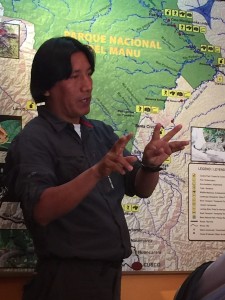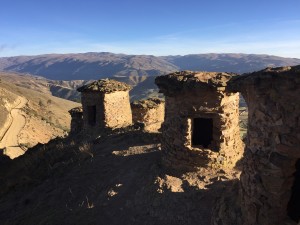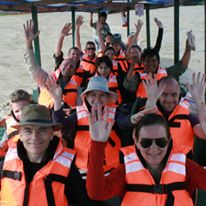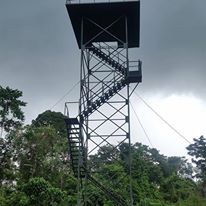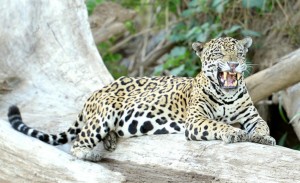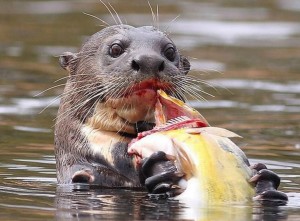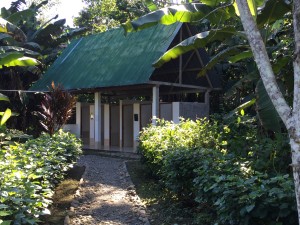I had the chance to sit down with Ryse Huamani, Manager of the Bonanza Ecological Reserve (located in Manu National Park, Peru) in his offices in Cuzco, Peru on April 27, 2016.
Ryse, tell me about how you decided to become a Naturalist Tour Guide and owner of the Bonanza Lodge in Manu National Park.
In 1980 my parents left the highlands of Peru near Cuzco and went into the jungle. They decided to leave because my father had 13 brothers and sisters, and their home with my grandparents was too small for all of them. At that time, the jungle was completely empty of people. I joined them in 1982 as a 3 year old with many of my cousins, aunts, and uncles, and grew up in the jungle. Life was difficult, and many of my cousins died of diseases. Because of the difficulties, they eventually all left, one by one. But my father didn’t want to leave—he loved the jungle, so our family stayed.
I remember that when I was very young, my siblings and I used to go for a swim in the river. My mother would go along to wash clothes. Sometimes we would see a group of the very first tourists into the Park coming down in a boat, and they would often stop at our home. I guess that we were one of the tourist attractions. The guests would ask: “Who is this family and how do they live?” The guides would sometimes pull over, and we kids would either run naked into the jungle, or pretend to be giant otters. That’s when I first saw foreigners, and I thought: “What an amazing job…I want to do that. I want to work with all these foreigners who are so different from all the people I know.”
After my brothers and I finished our secondary school education, my father asked: “Now that you’ve finished school, what are you going to do with the land?” We figured we had two options. One was that we could go in with chain saws and cut down the wood, but that’s hard and dangerous work. And it leaves the jungle in very bad shape. The other was to follow that dream I had as a youngster and start working with tourists. So after secondary school I studied to become a guide at a college for 3 years.
How has the company evolved over time?
In the year 2000 I told my father I was going to bring in tourists. To do so, I came here to Cuzco and made flyers and handed them out in the street. It took a while, but eventually we starting to sign up people to come for a jungle visit. When we started the business, we slept in tents. It was a good experience, and it was very beautiful, but it wasn’t too good during the rainy season. In 2003, we built a big shelter where we could go when it rains. The next year we built platforms to put the tents on to get away from the wet and bugs. In 2005, we decided to build a better lodge and a few cabins. We didn’t know how big the business would become, and we’ve been expanding since then. Today all of the cabins have electricity, there are wash and shower rooms. Our cabins have room for up to 20 people at one time. At this point we don’t have plans to keep expanding with more cabins at our main lodge because we want to focus on quality work.
As far as our land, we now have around 12,500 hectares. That’s quite large. If you were to walk from the north to the south, it will take you about two days, and from east to west, about one and a half days. It’s rich in wildlife and expensive wood, so a lot of people want to take over parts since we’re next to the park, but we want to keep it, protect it, and use it in a wise way.
You have two main types of tours based out of your lodge—the Cultural Zone Tour and the Reserve Zone Tour. I’ll be spending four days on the Cultural Zone Tour. What can I expect?
You will visit two of our lodges on this tour. It’s a fairly long trip from Cuzco to the Manu National Park, so we break it up by visiting some archeological sights and some communities with their markets along the way. The first night you will stay at our Rainforest Lodge, where, after a great meal you can do a night walk to see some tree frogs and spiders that live in the rainforest. Then the second day you go by car for 1.5 hours, then catch a boat for a 4.5-hour ride to get to the Bonanza Lodge. About half way along the river trip you stop at a natural hot water spring to relax in the soothing water for a while.
Once you get to the Bonanza Lodge, you will meet my parents, who run the Lodge. There you will check into your cabin, take a shower if you like, and then take a 2 hour walk deep in the jungle to arrive at our sleeping platform high up in the air above a mammal salt lick. During the night, everyone takes a 1-hour shift to keep watch to see what mammals might appear. We can’t guarantee you’ll see mammals—it depends a lot on the weather. On good nights you will probably see tapirs and deer coming into the salt lick to eat the mineral salts.
The third day you spend in the jungle on a number of walks. While you walk, the guides will tell you about the life in the jungle, how people live here and the cultural traditions, as well as their own personal experiences in the jungle. Your guides are well trained to notice any sounds that may indicate animals are close by.
Late in the afternoon, after about a 40-minute walk, you get to see the jungle from a new perspective–high up, in one of our 60-meter observation platform. You’ll probably get to see beautiful birds such as tanagers, toucans, macaws, as well as an amazing sunset. Your guide will bring telescopes to get close up views of these amazing birds. And often times you see monkeys jumping around.
On the way back you’ll be taking a night walk, where you will see many interesting creatures that are not out in the daytime… maybe some snakes, tarantulas, and maybe you’ll be lucky and see a jaguar.
On the last day you’ll leave around 5 AM in the boat, then meet up with your car to drive you back to Cusco, and arrive around 6:30 PM.
What about your tour to the Reserve Zone?
This is a great trip. It is six to seven days back to the Reserve Zone where you can often find jaguars, indigenous people who don’t know civilization, giant otters, and enormous clay licks. Very few places in the world can you find all four of these. It’s close to what is maybe the largest clay lick in the world—over 300 meters long and it is often covered with macaws who eat the clay to counteract the poison in the food they eat.
This tour goes into an area that’s completely protected. There are a lot of checkpoints where the government makes sure you have the right papers to get into the reserve. The government is very strict about companies going into the Reserve Zone to help protect the indigenous peoples and jungle. Like in the Cultural Zone, there are only seven companies who are certified by the government to offer these tours, but a couple of these companies are not doing well, so there will probably be fewer soon. Some of these other companies are 30-40 years old, and getting tired of all the work. But for me, I’m just starting and have lots of energy.
There actually are a few small communities within the Reserve Zone. The first road was built into that area in the 1960s, but the park wasn’t established until 1973. On our tours into that area we spend the first two nights in the Rainforest Lodge and then the Bonanza Lodge. Then it’s another long boat ride to get back into these communities. We stay at a couple of lodges there owned by people in the community.
What does your company do to help the communities and jungle where you work?
At our own lodge one thing we do is recycle the water from our sinks for irrigation. We also use the fruit such as bananas and papaya that grow there, compost our organic materials, and pack out all of our garbage.
We also made a decision a few years ago to do away with our thatched roofs. Those needed to be replaced every two or three years, and we had to go deeper and deeper into the jungle to find the palm leaves for all of our buildings, which does a lot of damage to the jungle. So we decided to use a metal roofing material that will last 20-30 years. It looks nice, but I know it’s not natural. However, we think it’s better than having to cut down palms every few years. And it’s much better for our guests who might have phobia about the unwanted visitors that often live in thatched roof houses, such as snakes and spiders.
We also try to help out individuals and communities within the Cultural and Reserve Zones. In June I’m going in with a team of doctors, nurses, and dentists to work with individuals who may not have good access to medical centers. We also provide furniture, clothing, medicines, tools such as machetes, and help set up libraries. We also work with communities to help with their rubbish. They often don’t know what to do with it—they sometimes just throw it out in the street. We’ve even had some tourist groups focused on helping clean up the communities. And we show them how to compost their organic garbage.
All of our staff are from indigenous communities, and our salaries are higher than other companies so they can help their families and be successful. That means there is a lot of demand for jobs with our company, and we’re able to select the best. And all of the money we make after paying our guides and our supplies goes back into the purchase of more jungle so we can help preserve it. We are young, but we have all these crazy ambitions.
You can learn more about the Bonanza Lodge at their website http://www.bonanzatoursperu.com/




